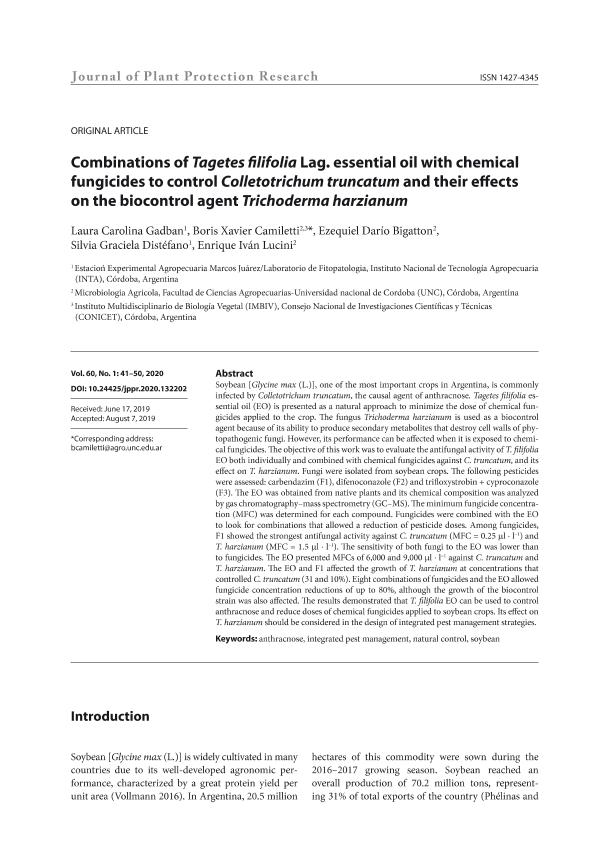Mostrar el registro sencillo del ítem
dc.contributor.author
Gadbán, Laura Carolina

dc.contributor.author
Camiletti, Boris Xavier

dc.contributor.author
Bigatton, Ezequiel Darío

dc.contributor.author
Distéfano, Silvia Graciela
dc.contributor.author
Lucini, Enrique Iván

dc.date.available
2021-10-28T20:23:28Z
dc.date.issued
2020-02
dc.identifier.citation
Gadbán, Laura Carolina; Camiletti, Boris Xavier; Bigatton, Ezequiel Darío; Distéfano, Silvia Graciela; Lucini, Enrique Iván; Combinations of Tagetes filifolia Lag: Essential oil with chemical fungicides to control Colletotrichum truncatum and their effects on the biocontrol agent Trichoderma harzianum; Polish Academy of Sciences; Journal of Plant Protection Research; 60; 1; 2-2020; 41-50
dc.identifier.issn
1427-4345
dc.identifier.uri
http://hdl.handle.net/11336/145409
dc.description.abstract
Soybean [Glycine max (L.)], one of the most important crops in Argentina, is commonly infected by Colletotrichum truncatum, the causal agent of anthracnose. Tagetes filifolia essential oil (EO) is presented as a natural approach to minimize the dose of chemical fungicides applied to the crop. The fungus Trichoderma harzianum is used as a biocontrol agent because of its ability to produce secondary metabolites that destroy cell walls of phytopathogenic fungi. However, its performance can be affected when it is exposed to chemical fungicides. The objective of this work was to evaluate the antifungal activity of T. filifolia EO both individually and combined with chemical fungicides against C. truncatum, and its effect on T. harzianum. Fungi were isolated from soybean crops. The following pesticides were assessed: carbendazim (F1), difenoconazole (F2) and trifloxystrobin + cyproconazole (F3). The EO was obtained from native plants and its chemical composition was analyzed by gas chromatography–mass spectrometry (GC–MS). The minimum fungicide concentration (MFC) was determined for each compound. Fungicides were combined with the EO to look for combinations that allowed a reduction of pesticide doses. Among fungicides, F1 showed the strongest antifungal activity against C. truncatum (MFC = 0.25 µl l–1) and T. harzianum (MFC = 1.5 µl l–1). The sensitivity of both fungi to the EO was lower than to fungicides. The EO presented MFCs of 6,000 and 9,000 µl l–1 against C. truncatum and T. harzianum. The EO and F1 affected the growth of T. harzianum at concentrations that controlled C. truncatum (31 and 10%). Eight combinations of fungicides and the EO allowed fungicide concentration reductions of up to 80%, although the growth of the biocontrol strain was also affected. The results demonstrated that T. filifolia EO can be used to control anthracnose and reduce doses of chemical fungicides applied to soybean crops. Its effect on T. harzianum should be considered in the design of integrated pest management strategies.
dc.format
application/pdf
dc.language.iso
eng
dc.publisher
Polish Academy of Sciences

dc.rights
info:eu-repo/semantics/openAccess
dc.rights.uri
https://creativecommons.org/licenses/by-nc-nd/2.5/ar/
dc.subject
ANTHRACNOSE
dc.subject
INTEGRATED PEST MANAGEMENT
dc.subject
NATURAL CONTROL
dc.subject
SOYBEAN
dc.subject.classification
Otras Ciencias de la Tierra y relacionadas con el Medio Ambiente

dc.subject.classification
Ciencias de la Tierra y relacionadas con el Medio Ambiente

dc.subject.classification
CIENCIAS NATURALES Y EXACTAS

dc.title
Combinations of Tagetes filifolia Lag: Essential oil with chemical fungicides to control Colletotrichum truncatum and their effects on the biocontrol agent Trichoderma harzianum
dc.type
info:eu-repo/semantics/article
dc.type
info:ar-repo/semantics/artículo
dc.type
info:eu-repo/semantics/publishedVersion
dc.date.updated
2021-09-29T14:40:17Z
dc.identifier.eissn
1899-007X
dc.journal.volume
60
dc.journal.number
1
dc.journal.pagination
41-50
dc.journal.pais
Polonia

dc.journal.ciudad
Poznan
dc.description.fil
Fil: Gadbán, Laura Carolina. Instituto Nacional de Tecnología Agropecuaria. Centro Regional Córdoba. Estación Experimental Agropecuaria Marcos Juárez; Argentina
dc.description.fil
Fil: Camiletti, Boris Xavier. Universidad Nacional de Córdoba. Facultad de Ciencias Agropecuarias. Departamento de Recursos Naturales. Cátedra de Microbiología Agrícola; Argentina. Consejo Nacional de Investigaciones Científicas y Técnicas. Centro Científico Tecnológico Conicet - Córdoba. Instituto Multidisciplinario de Biología Vegetal. Universidad Nacional de Córdoba. Facultad de Ciencias Exactas Físicas y Naturales. Instituto Multidisciplinario de Biología Vegetal; Argentina
dc.description.fil
Fil: Bigatton, Ezequiel Darío. Universidad Nacional de Córdoba. Facultad de Ciencias Agropecuarias. Departamento de Recursos Naturales. Cátedra de Microbiología Agrícola; Argentina. Consejo Nacional de Investigaciones Científicas y Técnicas. Centro Científico Tecnológico Conicet - Córdoba; Argentina
dc.description.fil
Fil: Distéfano, Silvia Graciela. Instituto Nacional de Tecnología Agropecuaria. Centro Regional Córdoba. Estación Experimental Agropecuaria Marcos Juárez; Argentina
dc.description.fil
Fil: Lucini, Enrique Iván. Universidad Nacional de Córdoba. Facultad de Ciencias Agropecuarias. Departamento de Recursos Naturales. Cátedra de Microbiología Agrícola; Argentina
dc.journal.title
Journal of Plant Protection Research
dc.relation.alternativeid
info:eu-repo/semantics/altIdentifier/url/http://www.plantprotection.pl/Combinations-of-Tagetes-filifolia-Lag-essential-oil-with-chemical-fungicides-to-control,111598,0,2.html
dc.relation.alternativeid
info:eu-repo/semantics/altIdentifier/doi/http://dx.doi.org/10.24425/jppr.2020.132202
Archivos asociados
